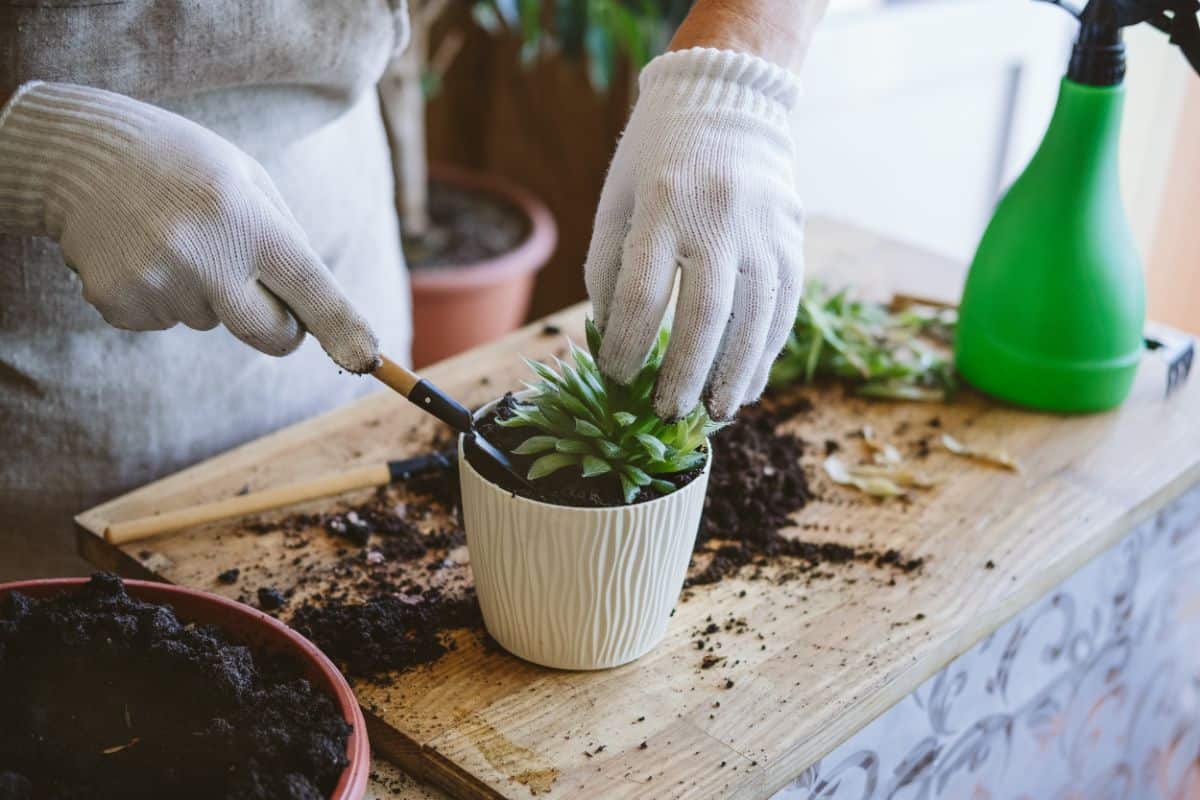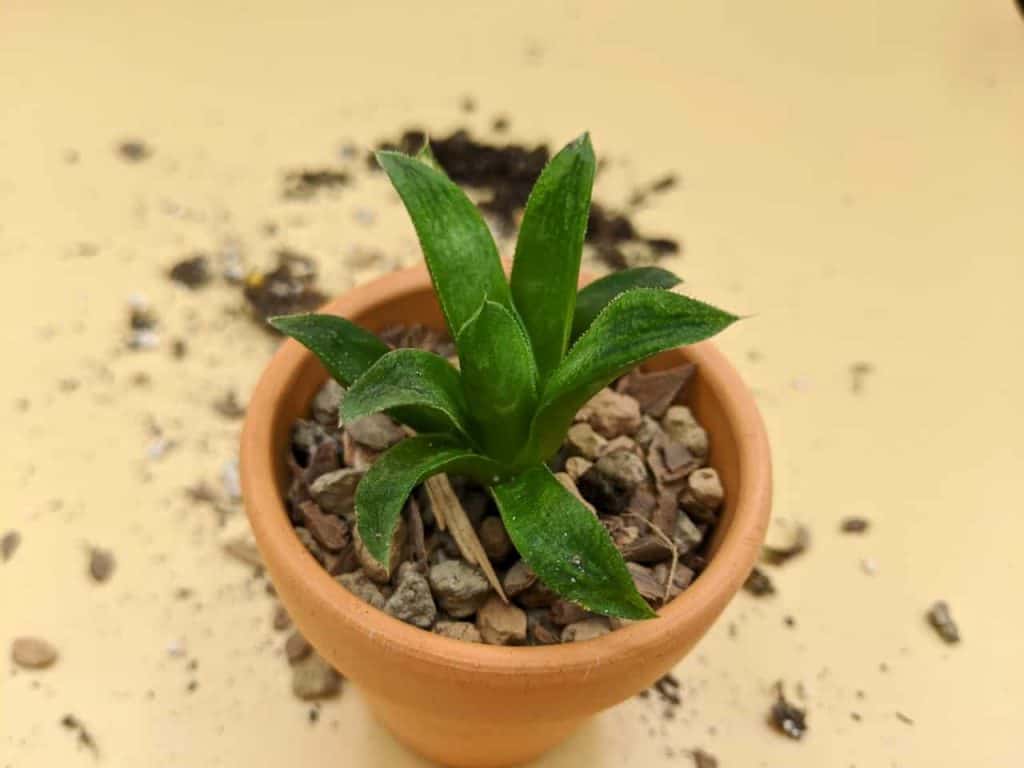
Transplanting your succulents is a relatively simple process, but how do you know when it’s time to repot? Unfortunately, our plants can’t tell us when they’re ready to move on to a bigger or better container, so we need to carefully monitor them for certain signs.
Now that you’ve decided to transplant your succulents, you may be wondering if there’s a certain time of year that’s best for repotting or if you can do it whenever they’re ready. Don’t worry, we’ve got all the information you need to make the best choices when transplanting your succulents and cacti.
Read Related Topic: Best Light Cycle for Flowering Succulents
Jump to:
When to Transplant Succulents

Succulent Has Outgrown Its Pot
The most obvious sign that it’s time to transplant your succulents or cacti is when they’ve outgrown their pots. Although they tend to be slow-growing plants, there will come a point when your succulent needs to be moved to a larger container.
If you’re unsure of whether your succulent has outgrown its current pot, consider how much room it has to grow. If your pot contains more than one plant, you’ll want to think about how much space each individual plant has to expand before it reaches the limits of the container.
Another more obvious sign that your succulent or cactus has outgrown its container, especially if it’s a shallow container, is a visible root system. You may notice your plant’s roots growing out of the drainage hole of the container. Your pot should always be big enough to contain your plant’s entire root system.
Read Also: How long Do Succulents Live
Soil No Longer Nutritious
Even if your succulent hasn’t outgrown its current container, if it’s been in the same pot for a significant amount of time, it may be time to transplant in order to refresh the soil. Even if you feed your plants regularly, the soil’s nutrients will eventually become depleted.
Compaction is also a common problem with old soil. Even if you have integrated large particles such as perlite or pumice into your soil mixture, it can still become compacted over time. Transplanting is a great way to not only restore nutrients to your plant’s soil but airflow as well.
When your succulent soil needs refreshed, you may notice your plant looking a little under the weather despite your best efforts. Fertilizer can make some difference, but you might not see the improvement you’d expect. Most importantly, if you can’t remember the last time you transplanted that particular plant, it’s definitely time to do so.
New Succulents or Cacti

Bringing new succulents into your home is an exciting time, but it may also be an ideal time to transplant them into new pots. Succulents bought from big box stores are notorious for having been planted in less than ideal soil.
Many store-bought succulents have been planted in soil that’s better suited for flowers and vegetables than drought loving plants. So, unless you’re purchasing your plants from a nursery with staff that’s knowledgeable about succulents, you probably want to transplant your new treasures as soon as you bring them home.
Read Related Article: How Do Succulents Reproduce
Potential Health Problems
Transplanting can also be done if you suspect your plants may be having root problems. Issues like root rot are difficult to detect without actually removing the plant from the soil to see what’s going on.
No products found.
If you suspect there may be a problem with your plant’s root system, it may be a good idea to transplant it just so you can have the opportunity to check everything out. This is true not only for root rot, but for certain types of pests as well. If you think your soil may be infected or infested, it’s definitely time to transplant.
If you’re worried about your plant’s health, you might also want to consider sterilizing the new soil prior to transplanting. Sterilizing is a great way to ensure that you aren’t introducing your more delicate plants to unwanted bacteria, fungus, or pests.
How Often Do Succulents Need to be Transplanted?

As with most aspects of succulent gardening, the frequency at which you need to transplant your succulents will vary according to what species you have in your collection. Some may need to be transplanted every year, while others may be able to go longer.
Most gardeners recommend transplanting succulents at least every two years or so. Waiting much longer allows the soil to become depleted of nutrients and possibly too compacted for ideal root health.
While weight distribution isn’t necessarily a problem with many species of succulents, it can be with cacti. Cacti often just have a single stem, rather than branches and leaves, so they can become quite top-heavy once they reach a certain size.
Transplanting will give you the opportunity to make sure your cacti are anchored well in their pots. Moving them to larger, heavier pots will also reduce the risk of them toppling over the next time a gentle breeze goes through your garden.
Read Also: How to Separate Succulents
The Right Season for Transplanting

Most succulent experts recommend transplanting your beloved plants during their growing season. Spring, summer, and fall are usually the ideal seasons for repotting your succulents and cacti. Of course, different species have different growing seasons, so it’s important to know about the specific species in your collection. Species originating in the northern hemisphere will have a different growing season than those from the southern hemisphere!
The reason for this is that transplanting can put your plant under stress. Even the gentlest hands may accidentally damage a succulent’s root system during the moving process.
If your succulent is currently dormant, it may not have the resources to repair the damage right away, which puts your plant at risk of becoming infected by fungus or bacteria. During the growing season, any accidental damage is typically repaired rather quickly by the actively growing plant.
Additionally, if you transplant at the beginning of your plant’s growing season, it will have the entire season to grow and establish its roots in its new home. Transplanting closer to a succulent’s dormant season will give it only a limited amount of time to expand. This just gives your plant a better chance at survival.
Of course, this is not to say that you should never transplant during winter. In some areas, winters can be mild enough to have little effect on a succulent’s dormancy or put its health at risk. In certain situations, it may also be necessary for you to report your succulents during the dead of winter, regardless of the outside temperatures.
Transplanting during the growing season is simply a recommendation based on what’s ideal for your succulents and cacti. If your plant needs moved immediately, don’t hesitate to do so. However, if it’s not an emergency, you may just want to wait until spring to begin transplanting your succulents.
How to Transplant Succulents

First, you’ll want to choose a pot that is neither too small nor too large for your plant. You want to give it enough room to grow, but not much more. If you need more information on how to choose the right pot size for your plant, click here.
Next, you’ll need to gather your materials and make sure you have soil that is ideal for succulent growth. Don’t reuse old soil! You can either buy a potting mix designed specifically for succulents and cacti, or you can make your own. Your local gardening center or favorite online retailer should have everything you need.
After you’ve chosen the right container, you’re ready for transplanting. It’s best not to water your plants before you report them. Watering them afterward will help them recover from the stress of repotting and encourage new root growth.
To start, you want to gently remove your succulent from its current pot. Handle the plant as carefully as possible to minimize root damage. If you’re transplanting cacti, you may need to use certain handling techniques to ensure that you and your plant stay safe.
You can either gently tug at the base of your succulent’s stem, or you can tip the pot over and gently shake the plant out. Just be sure you’re there to catch it when it falls out. Once you’ve removed the plant, you want to gently shake the excess soil from the roots.
Gently kneading hard clumps of soil should be enough to break them up without damaging any roots but be careful! You can also stick your succulent roots into water to help clean the old soil away. This much water for a short period of time won’t be enough to damage them, just remember to remove the plant once the roots are clean.
Fill about ⅓ of the new pot with fresh soil and place the plant in the center of the container. You may need to hold the plant in place while you fill in the spaces around the roots. Chopsticks are a great way to stabilize the plant while you use two hands to fill the pot with soil. You can even gently tie your plant to the chopsticks for further stabilization.
Once the container is full, you can gently pack the soil. However, don’t pack the soil in too tightly as you’ll reduce airflow and possibly damage your plant’s roots. For more detailed information on how to report your succulents, read this article.
You Might Also Like:

